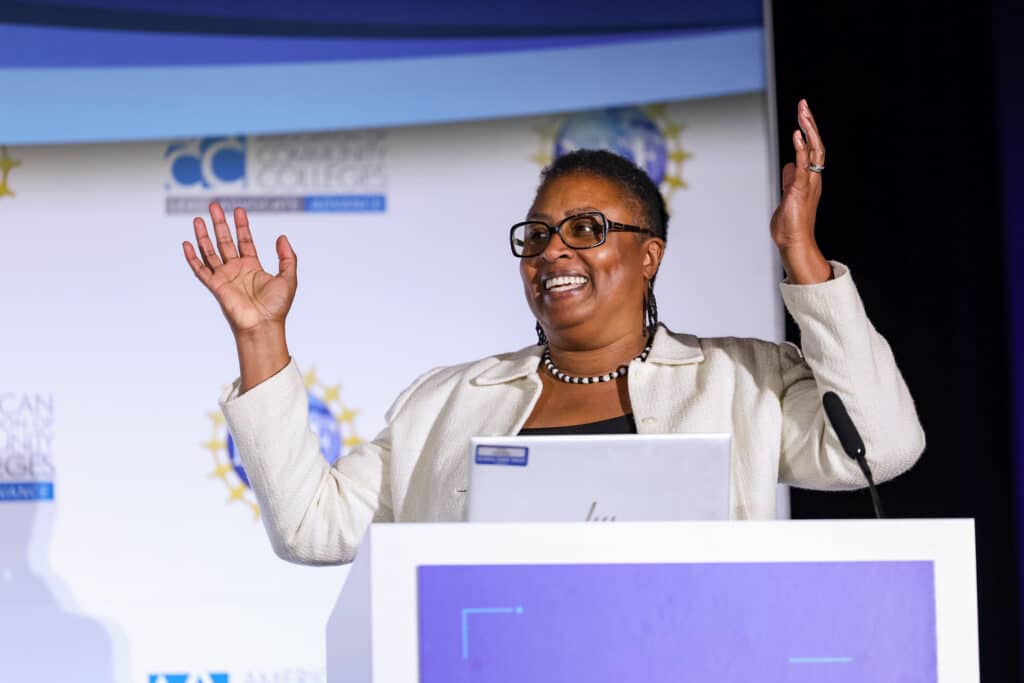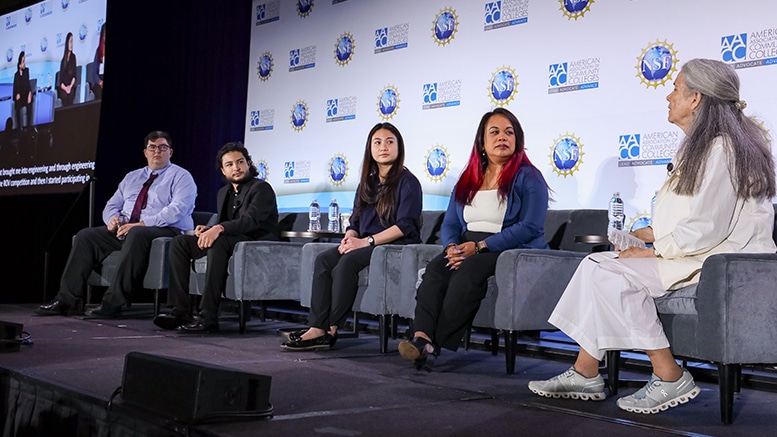Rosalyn Hobson Hargraves told the 48 students attending the 2024 Advanced Technological Education Principal Investigators’ Conference that they are her “why.”

For the past three years, Hargraves has served as the division director of the Division of Undergraduate Education at the National Science Foundation (NSF). She described herself as nostalgic because her time on loan to NSF is ending. She will soon return to Virginia Commonwealth University, where she was an associate professor in the Department of Electrical and Computer Engineering and an associate professor in the Department of Teaching and Learning.
Hargraves told the students who have learned in innovative programs funded with NSF’s Advanced Technological Education grants, “I want to help create for you the best educational opportunities and experiences so that it is a joy to be in those classes, and I want you to have the skills and tools necessary for you to achieve your career goals.”

She then asked the students to keep their “whys” in mind: “The reason why I want you to hold that ‘why’ is because sometimes the journey may not be easy. … Sometimes the thing that you wanted to do didn’t come as easily as you thought it should. But you hold to that ‘why.’ That ‘why’ might be to create something new. That ‘why’ might be economic prosperity. That ‘why’ might be because this is important. But, that ‘why’ will sustain you in your journey, because this is important work that we are doing.”
Student experiences
During the student panel discussion facilitated by V. Celeste Carter, lead ATE program director at NSF, two community college students and two community college alumni talked about their science, technology, engineering and math (STEM) learning experiences, made recommendations to faculty, and offered encouragement to students.
Tracy Naputi, an NSF Experiential Learning for Emerging and Novel Technologies (ExLENT) intern at Wacker Biotech in California, worked for 12 years in biotech after completing a certificate at San Diego Miramar College.
“I needed something that was fast for me to get the job quickly. And the biotech program gave me that. It was a two-semester program at that time and they promised that I would be able to have the skills to get into the field right away,” Naputi said, explaining she was a single parent when she enrolled.
She said she was proud that in recent years one of her six children began taking biotech courses in high school, has earned a certificate and is on track to earn an associate degree in biotechnology.
“Having these programs is another option for students like me that have other things that prevented them from having to take the normal pathway … It’s not a dead-end pathway,” Naputi said of her certificate. It allowed her to work in immunoassay development and quality control with biotechnology companies. She is currently taking bachelor’s degree courses.
Naputi urged educators to tell students how tasks woven into STEM courses, such as working with lab partners and reporting outcomes in PowerPoint presentations and scientific posters, are skills that employers want employees to have. She also recommended that STEM faculty work closely with employers.
“Collaboration with the industry leaders is very, very important too, so educators can stay up to date to be able to adjust their curriculum,” she said.
Robotics competitions uncover interests
Steven Dotts, a student at Arizona’s Estrella Mountain Community College, did not think he had time to participate in the college’s remotely operated vehicle (ROV) team, as an instructor suggested.
“People at community college are generally not there because they have the time to be able to go do a higher education degree. They’re there because they need their education degree to continue on their career path,” he said.
However, while working in the college’s maker space, he overheard the team’s planning. It was his first year in an associate-degree program — after working for five years in aircraft maintenance — and he began helping the team in small ways. The next year, he went all-in and became CEO of the Desert Star Robotics team. The team won second place at the 2024 MATE World Championship and he received the prestigious MATE Mariner Award.
“The technical skills that I learned through my technician program and my technical education applied everywhere,” he said.
Through the ROV competitions, Dotts discovered that he likes systems engineering and working at the interface between hydrology, electricity and ships’ instrumentation. He urged technical educators to teach students how regulations and regulators will affect their work.
“Trend monitoring [is] being improved every day with things like AI. And, yeah, it’s not just the structures and industry context. [It’s] also working with regulators, too,” he said.
Research opportunities opens paths
Ivan Alonso has used a programming certificate and associate degree in computer science from El Paso Community College (EPCC) to propel himself into a combined baccalaureate-master’s degree engineering program at the University of Texas at El Paso.
While carrying a heavy course load, he continues to work as a peer mentor in the computer science department at EPCC and conduct research on adversarial thinking with Christian Servin, EPCC professor of computer science and education research development coordinator.
“I believe the research is what has helped me to open a broader array of perspectives of how to perceive different aspects of technology,” Alonso said. This experience prompted him to take cybersecurity courses and minor in mathematics.
As a peer mentor, he has helped students gain hands-on experience with industry software tools and answered computer science questions students were reluctant to ask their professors. He recommended faculty improve their STEM recruitment pitches with more hands-on learning opportunities, especially to students who have not selected a major.
“I would really encourage all faculty members to develop more activities such as hackathons and workshops … a workshop can make a huge difference on students because it provides them with a notion of what the pathway will be,” he said.
Finding physics and a career path
Julia Corrales said that her innate curiosity about how things work meant she was always interested in a STEM career. But the four-year gap between graduating from high school and enrolling at Mount San Antonio College (Mt. SAC) left her “scared and also confused about the path I should take,” until she took a general physics course. Physics captivated her attention; she hopes to earn graduate degrees in it.
Now very comfortable at the California college, Corrales is a supplemental instruction leader for engineering physics 1, the treasurer of the Society of Women Engineers and an NSF ATE program ambassador.
This past summer she interned in a condensed matter lab at the University of California, Irvine. There she learned to use a scanning tunneling microscope and worked with graduate students to engineer parts and do tasks that involved chemistry, coding and other cross-discipline skills.
Carrales said that she enjoys conducting research and thinks that getting immersed in it early is important for community college students. “I think a lot of students are interested,” but they do not know how to get involved. Her applications to multiple university labs were rejected before she obtained a placement.
She suggested faculty offer workshops and seminars and advocate for programs that give students real-world experiences that are critical for students to obtain jobs.
Getting through the tough times
A community college educator in the audience asked the panelists how they had overcome difficulties to continue pursuing their goals.
Corrales said she has been fortunate to have “a great support system” of family and friends, and lately mentors at Mt SAC. “They keep encouraging me and also they understand that we’re students, we’re here to learn,” she said.
Naputi said changing her mindset helped her. “I used to be afraid to make mistakes until somebody once told me, don’t be afraid to fail because failing really only stands for first attempt in learning … That allows you to be able to learn from the mistakes. So that’s how I dealt with the difficulties in my pathway, and that’s how I continue to deal with the difficulties that come.”
Alonso suggested students not worry about sequential steps to achieve their goals, but to be open to “a dynamic pattern” that gives them a chance to try different things and find out what works for them.
Dotts was succinct: “Keep moving forward. It’s very easy to sit down and give up, but it’s very hard to always just continue working and thinking about what to do next, whether that be on that path you’re currently working on or a different path.”

